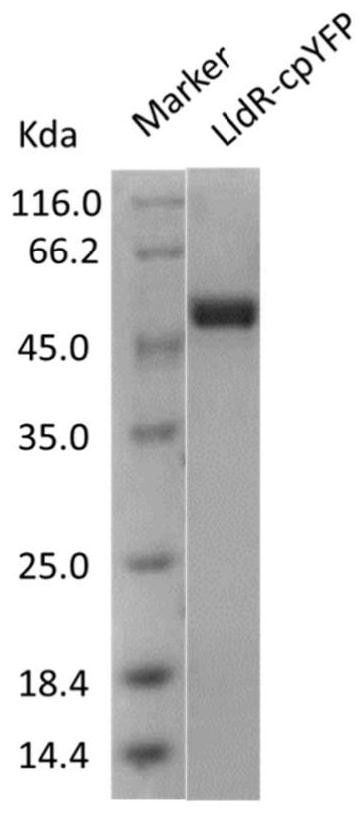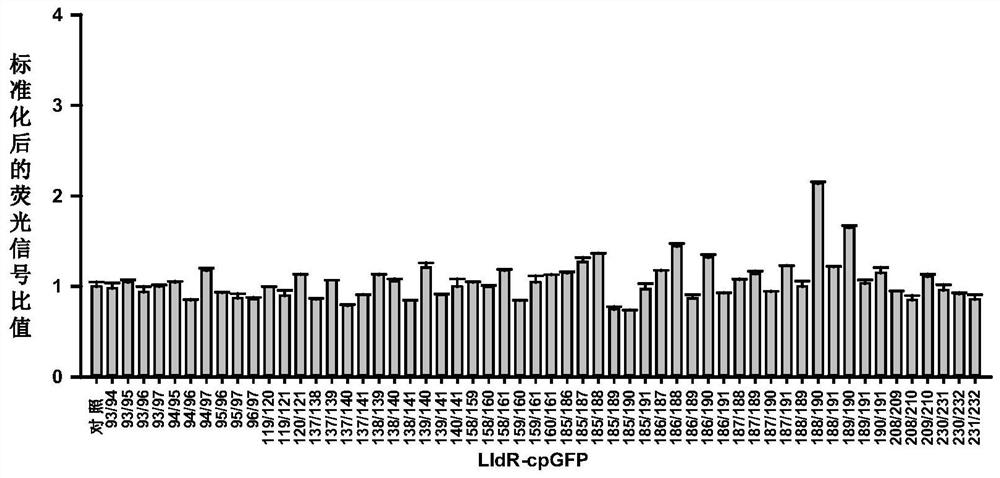Lactic acid optical probe as well as preparation method and application thereof
An optical probe and lactic acid technology, applied in the field of optical probes, can solve problems such as in-situ, real-time, dynamic, high-throughput and high-spatial-resolution detection, cell crushing, separation, extraction and purification, and unsuitability for living cell research. , to achieve large dynamic changes in fluorescence, easy to mature, and save the effect of sample processing steps
- Summary
- Abstract
- Description
- Claims
- Application Information
AI Technical Summary
Problems solved by technology
Method used
Image
Examples
Embodiment 1
[0141] Embodiment 1, lactic acid binding protein particles
[0142] The LldR (80-258) gene in the Escherichia coli gene was amplified by PCR, and the PCR product was recovered after gel electrophoresis and digested with BamHI and EcoRI, and the pCDFDuet1 vector was subjected to corresponding double digestion. After ligation with T4 DNA ligase, the product was used to transform MachI, and the transformed MachI was spread on LB plates (streptomycin sulfate 50ug / mL), and cultured at 37°C overnight. After plasmid extraction of the growing MachI transformants, PCR identification was performed. After the positive plasmid is correctly sequenced, the subsequent plasmid construction is carried out.
Embodiment 2
[0143] Example 2, Expression and Detection of cpYFP Optical Probes at Different Insertion Sites
[0144] In this example, based on pCDFDuet-LldR(80-258), the following site was selected to insert cpYFP according to the crystal structure of lactate-binding protein, and the corresponding pCDFDuet-LldR(80-258)-cpYFP plasmid was obtained: 93 / 94, 93 / 95, 93 / 96, 93 / 97, 94 / 95, 94 / 96, 94 / 97, 95 / 96, 95 / 97, 96 / 97, 119 / 120, 119 / 121, 120 / 121, 137 / 138 , 137 / 139, 137 / 140, 137 / 141, 138 / 139, 138 / 140, 138 / 141, 139 / 140, 139 / 141, 140 / 141, 158 / 159, 158 / 160, 158 / 161, 159 / 160, 159 / 161, 160 / 161, 185 / 186, 185 / 187, 185 / 188, 185 / 189, 185 / 190, 185 / 191, 186 / 187, 186 / 188, 186 / 189, 186 / 190 , 186 / 191, 187 / 188, 187 / 189, 187 / 190, 187 / 191, 188 / 189, 188 / 190, 188 / 191, 189 / 190, 189 / 191, 190 / 191, 208 / 209, 208 / 210, 209 / 210, 230 / 231, 230 / 232 or 231 / 232. The amino acid sequences of exemplary optical probes are shown in Table 1.
[0145] Table 1. Sequences of Optical Probes
[0146]
[0147]
[0148] The ...
Embodiment 3
[0151] Example 3, Expression and detection of cpGFP optical probes at different insertion sites
[0152] According to the method in Example 2, cpYFP was replaced with cpGFP to construct a fluorescent probe for lactate green fluorescent protein, expressed and detected according to the method in Example 2. Such as image 3 As shown, the detection results show that the optical probes responding to lactic acid more than 1.5 times are at the 188 / 190 and 189 / 190 sites.
PUM
 Login to View More
Login to View More Abstract
Description
Claims
Application Information
 Login to View More
Login to View More - R&D
- Intellectual Property
- Life Sciences
- Materials
- Tech Scout
- Unparalleled Data Quality
- Higher Quality Content
- 60% Fewer Hallucinations
Browse by: Latest US Patents, China's latest patents, Technical Efficacy Thesaurus, Application Domain, Technology Topic, Popular Technical Reports.
© 2025 PatSnap. All rights reserved.Legal|Privacy policy|Modern Slavery Act Transparency Statement|Sitemap|About US| Contact US: help@patsnap.com



